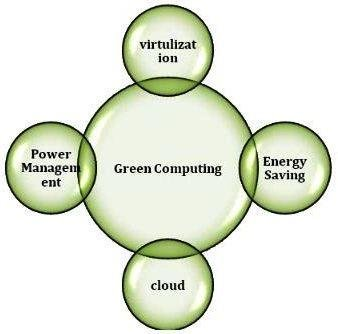Definition: "the study and practice of designing, manufacturing, using, and disposing of computers, servers, and associated subsystems—such as monitors, printers, storage devices, and networking and communications systems — efficiently and effectively with minimal or no impact on the environment”
${tocify}
Introduction
The primary objective of such a program is to account for the triple bottom line (or "People, Planet, Profit").
The term "green computing" was probably coined shortly after the Energy Star program began.
The goals are similar to green chemistry namely to reduce the use of hazardous materials; maximize energy efficiency during the product's lifetime; and promote recyclability or biodegradability of defunct products and factory waste.
The Green Electronics Council offers the Electronic Products Environmental Assessment Tool (EPEAT) to assist in the purchase of "green" computing systems.
Climate Savers Computing Initiative (CSCI) is an effort to reduce the electric power consumption of PCs in active and inactive states. The name stems from the World Wildlife Fund's Climate Savers program, which was launched in 1999. The WWF is also a member of the Computing Initiative.
In 1992, the U.S. Environmental Protection Agency launched Energy Star, a voluntary labeling program that is designed to promote and recognize energy-efficiency in monitors, climate control equipment, and other technologies. This resulted in the widespread adoption of sleep mode among consumer electronics. Concurrently, the Swedish organization TCO Development launched the TCO Certification program to promote low magnetic and electrical emissions from CRT-based computer displays; this program was later expanded to include criteria on energy consumption, ergonomics, and the use of hazardous materials in construction
Why should a company promote green, or energy efficient computing?
• Climate Change: First and foremost, conclusive research shows that CO2 and other emissions are causing global climate and environmental damage
• Savings: Green computing can lead to serious cost savings over time.
• Reliability of Power: Energy efficient systems helps ensure healthy power systems. Also, more companies are generating more of their own electricity, which further motivates them to keep power consumption low.
• Computing Power Consumption has Reached a Critical Point: Data centers have run out of usable power and cooling due to high densities.
Steps that can be taken
Here are some steps that can be taken:
• Power-down the CPU and all peripherals during extended periods of inactivity.
• Try to do computer-related tasks during contiguous, intensive blocks of time, leaving hardware off at other times.
• Power-up and power-down energy-intensive peripherals such as laser printers according to need.
• Use liquid-crystal-display (LCD) monitors rather than cathode-ray-tube (CRT) monitors.
• Use notebook computers rather than desktop computers whenever possible.
• Use the power-management features to turn off hard drives and displays after several minutes of inactivity.
• Minimize the use of paper and properly recycle waste paper.
• Dispose of e-waste according to federal, state and local regulations.
• Employ alternative energy sources for computing workstations, servers, networks and data centers.
Approaches to green computing
1. Virtualization
Computer virtualization is the process of running two or more logical computer systems on one set of physical hardware. The concept originated with the mainframe operating systems of the 1960s, but was commercialized for x86-compatible computers only in the 1990s. With virtualization, a system administrator could combine several physical systems into virtual machines on one single, powerful system, thereby unplugging the original hardware and reducing power and cooling consumption.
Eg: Intel Corporation and AMD
2. Power management
The Advanced Configuration and Power Interface (ACPI), an open industry standard, allows an operating system to directly control the power saving aspects of its underlying hardware. This allows a system to automatically turn off components such as monitors and hard drives after set periods of inactivity. In addition, a system may hibernate, where most components (including the CPU and the system RAM) are turned off. ACPI is a successor to an earlier Intel-Microsoft standard called Advanced Power Management, which allows a computer's BIOS to control power management functions.
Some programs allow the user to manually adjust the voltages supplied to the CPU, which reduces both the amount of heat produced and electricity consumed. This process is called under volting. Some CPUs can automatically under volt the processor depending on the workload.
3. Low performance computers
As of 2007, several personal computer vendors (e.g., Everex, Linutop, Systemax, Zonbu and OLPC) ship dedicated low-power PCs. These systems provide minimal hardware peripherals and low performance processors, which makes them impractical for applications that require a lot of processing power such as computer gaming and video production. A low power PCs is usually much smaller than traditional desktop. The limited capacity for upgrades, low performance and proprietary may lead to shorter life spans and greater difficulty in repair. Older laptops may provide similar performance with low power consumption. Reusing second-hand laptops may be an even more energy and material efficient alternative to such systems.
Routers, such as those compatible with the Linksys WRT54G, may be adapted for use in low power applications using replacement firmware.
4. More efficient components
Power supply: Desktop computer power supplies (PSUs) are generally 70–75% efficient, dissipating the remaining energy as heat.
Storage: Smaller form factor (e.g. 2.5 inch) hard disk drives often consume less power than physically larger drives.
Display: LCD monitors typically use a cold-cathode fluorescent bulb to provide light for the display. Some newer displays use an array of light-emitting diodes(LEDs) in place of the fluorescent bulb, which reduces the amount of electricity used by the display.
5. Materials recycling
Recycling computing equipment can keep harmful materials such as lead, mercury, and hexavalent chromium out of landfills, but often computers gathered through recycling drives are shipped to developing countries where environmental standards are less strict. Eg: printer cartridges, paper, and batteries.

